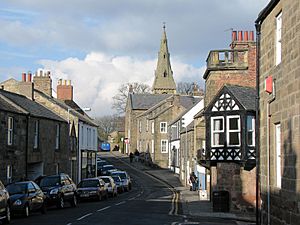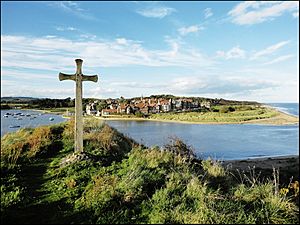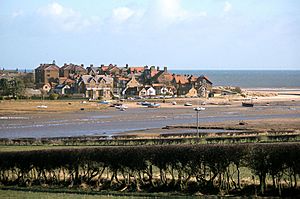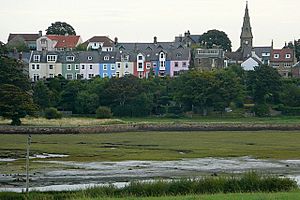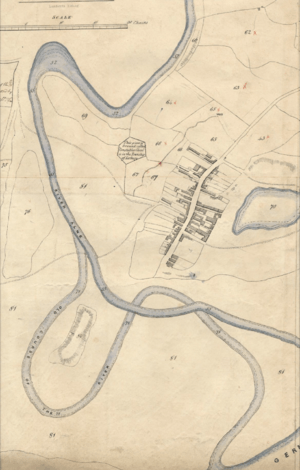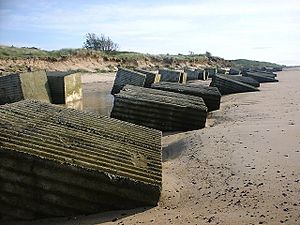History of Alnmouth facts for kids
Alnmouth is a small village and port in Northumberland, England. Its history goes way back to the Stone Age! People started building a proper village here in 1152. It became an important port and market town around 1207. Before that, there were signs that people used this area for a very long time. The port was busiest in the 1700s and 1800s. Later, in the late 1800s and 1900s, Alnmouth became a popular holiday spot by the sea.
Contents
How Alnmouth Started
Alnmouth began as a village thanks to William de Vesci. He was an important local Norman lord. In 1152, he received permission to create a settlement. This new village was on a piece of land about 296 acres big. He likely wanted to build a good seaport there.
The layout of Alnmouth is like many old medieval towns. It has one main road, now called Northumberland Street. Long, narrow plots of land, called burgage plots, ran off this road.
Ancient Times
We don't know much about what was here before the Norman village. But people probably used the land near the river mouth for a very long time. Coastal areas were often among the first places where humans settled in Britain.
Some flint tools from the Mesolithic period have been found. This was before 4000 BCE, when the sea level was higher. A large Mesolithic camp was also found a few miles away at Howick. We haven't found proof from the Neolithic period, but people likely still lived or used the area.
Several Bronze Age items have been found near Alnmouth. These include stone burial boxes called cists and a spear-head. An old field name suggests there might have been a lost burial mound (barrow) too. An earth bank to the north, now part of the golf course, is thought to be from the Iron Age.
Roman Times
No Roman remains have been found right in Alnmouth. But it's likely the Romans knew about and used the river mouth. This might have been when their empire reached the Antonine Wall in Scotland.
A writer named Ptolemy mentioned the river Alaunus in the 2nd century CE. Later, another old map noted a place called Alauna. A large Roman fort, also called Alauna, was built about 9.5 miles upstream. The river's harbour would have been useful for the Romans. It helped with military trips and trade. However, boats could not go past Lesbury, about 3.2 km upstream.
Early Christianity
The Northumberland Coast has a long history with early Christianity. The name Adtwifyrdi was used by the Venerable Bede. It means "at the two fords" and likely refers to where the River Aln meets another stream at its mouth.
According to Bede, an important meeting happened here in 684. Archbishop Theodore led it, and King Ecgfrith of Northumbria was there. At this meeting, Bishop Tunberht was removed, and St Cuthbert was chosen as Bishop of Lindisfarne. A cross from the 800s or 900s found on Church Hill suggests this area was important before the Norman Conquest.
There are signs that a monastery was formed at Alnmouth. Records show that Eustace fitz John gave land to monks in 1147. A church called St Waleric was known to exist by 1305. Its exact spot on Church Hill is unclear. By 1771, it was in ruins, shown as a roofless building.
Alnmouth Becomes a Port
Alnmouth's port has a long, up-and-down history of 800 years. Eustace de Vesci got royal permission to set up a port and a fish market in 1207 or 1208. The port was used for fishing, but also for local and foreign trade.
Richard de Emeldon, a local landowner, helped develop the harbour. In 1306, the Crown asked Alnmouth to provide a boat for a military trip. This shows Alnmouth was a known port. We don't have old remains of the port's buildings. There were probably just mooring posts and maybe wooden docks. The river and mudflats offered a safe place for boats to land.
The Scots attacked Alnmouth in 1336, greatly reducing its population. In 1296, 28 people paid tax; in 1336, only one did. The Black Death in 1348 also caused problems. Border Reiving (raiding) was always a threat. The port became part of Alnwick Castle in 1452. By 1492, the village had recovered, with many landowners. In 1529, the villagers agreed with the Earl of Northumberland to improve the harbour if he supplied the wood.
A Quiet Time (1400s and 1500s)
The village became less busy in the 1400s and 1500s. In 1594, the Earl of Northumberland wrote that the village was "depeopled." A survey in 1614 noted that Alnmouth was "in great ruin and decay," though it had improved a bit.
A 1567 survey found that 20 out of 60 households in Alnmouth were involved in fishing. The rights to fish were given to the Duke of Northumberland after the monasteries were closed down.
Some sources say that the French took over and fortified Alnmouth during the time of Queen Elizabeth I. They supposedly did this to support Mary, Queen of Scots. The Schooner Hotel was built in the 1600s. Local newspapers say it is one of the most haunted places in the UK. However, old records from that time don't mention the French taking over.
Good Times in the 1600s and 1700s
Alnmouth's prosperity improved in the 1600s. In the 1700s, trade at the port grew a lot. This was common for many ports then, as trade increased. The main export from Alnmouth was grain. Records mention a "corn road" to Alnmouth from as far as Hexham.
In 1813, Alnmouth exported 44,266 quarters of grain. This was about half as much as Berwick-upon-Tweed, but twice as much as Newcastle. A major import was guano from Peru. This was used to improve farms at the time. A guano shed still stands away from the village, probably because of the smell. Other exports included coal, eggs, pork, and pickled salmon for London. Wool went to the Yorkshire woolen industry. Imports included slate from Scotland and timber from Holland and Scandinavia. Sometimes, they even imported Madeira wine. The grain trade led to 16 granaries in the village. Some of these were later turned into homes.
The port also became a place for shipbuilding, though on a small scale. A 300-ton ship was launched in 1763 or 1765. Another 219-ton ship, the Providence, was launched in 1765. This industry supported others, like a sawmill and a ropery (where ropes were made). There is also evidence of salt-making by the river. At least five oyster farms were set up.
At its busiest, around 1750, up to 18 ships could be in the harbour at once.
The Port Declines
A change in the river's path was sometimes blamed for the port's decline. This happened on Christmas Day 1806. A big storm broke through the sandbank at Church Hill. This made the river flow straight to the sea instead of in a big loop.
In the 1800s, traffic at the port decreased. It stopped completely by the end of the century. The number of herring fishing boats went down. Grain exports fell as railways took over. Grain was then sent from bigger, more connected ports.
However, timber and slate imports seemed to continue. In 1887, 40 men worked in this business. Other riverside businesses were still busy. The sawmill did well, with 27 employees in 1891. There was also a large steam-powered mill for grain and sawing wood. The port's final blow was when the timber ship Joanna sank in the shallow harbour in 1896. After that, it was hard to get insurance for goods passing through Alnmouth.
Alnmouth Becomes a Holiday Spot
As the port declined, Alnmouth found a new purpose. It became a holiday and second-home resort. People had more money, which helped. Two main things made this happen. First, the arrival of railways. Second, the sale of the Gallon estate in 1843. This estate owned much of the village land.
The East Coast Main Line railway arrived near Alnmouth in 1847. A branch line from Alnwick to Bilton opened in 1850. A bridge was built across the Aln in 1857, connecting directly to Hipsburn. It was improved and renamed the Duchess's Bridge in 1864.
Now, large houses with sea views were built. Old granary buildings were turned into homes or pulled down for new cottages. Maps from 1897 show a holiday camp, a garden tea-room, and many beach huts. Heated baths were available at the village's gas station. A golf course was built in 1869. It is believed that Mungo Park, the club's first professional, designed it.
In 1860, Alnmouth was chosen as one of 14 weather stations. The Duke of Northumberland gave it a barometer. The barometer and recent readings were displayed publicly. This helped fishermen know the weather and reduce losses at sea. The barometer is still on display in a cottage window on the main street. In November 1876, a new church, St John the Baptist, was opened on Northumberland Street.
Coastal Defences
Alnmouth has been affected by wars and the fear of war throughout its history. The Scots attacked it in the 1300s. The French may have occupied it in the 1500s. In the 1700s, Alnmouth's ships risked attacks from French privateers (armed ships).
In August 1779, two French privateers fought a British warship near Alnmouth. A month later, on September 23, 1779, the American privateer John Paul Jones attacked Alnmouth. He was supporting the American War of Independence. Jones fired a cannonball at the town. It missed the church tower and hit a farmhouse roof. In 1796, an Alnmouth ship, the Two Brothers, was captured by a privateer.
The early 1800s saw trade affected by the Napoleonic Wars. Fear of a French invasion lasted until late in the century. The Duke of Northumberland kept an army, the Percy volunteers, ready for this threat. A gun battery was placed overlooking Alnmouth in 1852.
Similar fears of invasion arose during World War II. Many defences were built on Alnmouth's beaches. These included concrete anti-tank blocks and an anti-tank ditch. There were also pill-boxes (small concrete bunkers). The old gun battery was strengthened. Firing slits were built into the walls of the guano shed on Church Hill. You can still see remains of many of these defences today.
The village saw several events during World War II. Two German planes were shot down in April 1941. On June 8, 1941, a barrage balloon at Alnmouth was shot down. In August, the railway line south of the village was bombed by a low-flying plane. Alnmouth was also attacked by planes on June 3, 1941. On November 8 of that year, two bombs were dropped on the village. One hit a house on Argyle Street, killing six women and one man.


